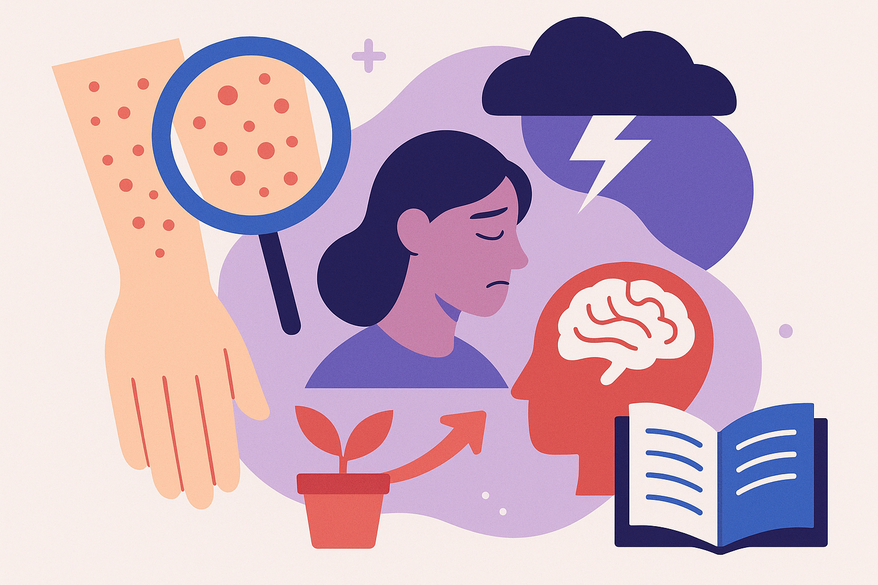Exploring the Psychological Effects of Chronic Rashes and Effective Coping Strategies
Discover how chronic rashes affect mental health and learn coping strategies. Understand the psychological effects and improve your well-being with expert insights.

Estimated reading time: 8 minutes
Key Takeaways
- Chronic rashes affect both skin and mental health.
- Stress and emotions can trigger or worsen flare-ups.
- Social stigma and body-image concerns are common.
- Mind-body strategies and professional support improve outcomes.
- Combining dermatological treatments with therapy fosters resilience.
Table of Contents
- 1. Understanding Chronic Rashes
- 2. Psychological Impact Overview
- 3. Emotional Challenges
- 4. Coping Strategies & Mental Health Support
- 5. Case Studies & Personal Experiences
- 6. Role of Medical and Psychological Interventions
- 7. Conclusion
- 8. Additional Resources
- 9. FAQ
1. Understanding Chronic Rashes
Chronic rashes are skin conditions lasting more than six weeks, often marked by:
- Persistent redness and inflammation
- Intense, unrelenting itching
- Swelling, hives, or raised plaques
Common forms include chronic urticaria, atopic dermatitis, and psoriasis. These symptoms can disrupt sleep, daily routines, and social confidence, affecting roughly 1% of people at any time.
2. Psychological Impact Overview
The mind-body connection in dermatology means stress can worsen rashes, and visible flares can fuel anxiety or depression:
- Elevated cortisol levels worsen inflammation and itching.
- Over 30% of dermatology patients report psychosocial concerns.
- Fear of flares leads to heightened vigilance and stress.
Learn more about managing triggers in Stress Related Rash Triggers: How Stress and Sleep Impact Your Skin Health.
3. Emotional Challenges
Living with a chronic rash often involves:
- Body-Image Struggles: Visible lesions can erode self-esteem.
- Social Stigma: Misunderstandings may cause isolation.
- Daily Treatment Burden: Rigorous routines and disrupted sleep add stress.
These hurdles can trigger cycles of avoidance and shame, making peer support and education vital.
4. Coping Strategies & Mental Health Support
Stress Management Techniques
- Mindfulness Meditation: 10 minutes of breath awareness to lower cortisol.
- Progressive Muscle Relaxation: Sequential tension-release exercises.
- Guided Imagery: Visualize calming scenes to distract from itch.
- Cognitive-Behavioral Techniques: Reframe negative thoughts in a diary.
Professional Support
- CBT or ACT for anxiety and body-image concerns
- Multidisciplinary dermatology-psychology clinics
Lifestyle & Self-Care
- Sleep Hygiene: Consistent schedule in a cool, dark room
- Skin Care: Fragrance-free products and broad-spectrum SPF
- Nutrition: Anti-inflammatory diet with omega-3s
- Visual Tracking: Use How to Track Rash Progress Pictures: A Step-by-Step Guide to monitor flares
Try the Rash Detector AI app for instant skin analysis reports.

5. Case Studies & Personal Experiences
Patient Vignette 1: Sarah (34) withdrew from social life until a therapy group helped her reclaim confidence.
Patient Vignette 2: Mark (27) reduced flares by 40% in six months using CBT to break his itch-anxiety cycle.
“Integrated emotional care boosts treatment adherence and quality of life.” — Dr. Emily Chen, dermatologist-psychologist
6. Role of Medical and Psychological Interventions
A bio-psycho-social approach combines:
- Dermatological Treatments: Topicals, antihistamines, biologics
- Psychotherapy: CBT, ACT, stress-reduction counseling
- Peer Support: Group programs and community resources
7. Conclusion
Chronic rashes carry an emotional toll—stress, anxiety, and social withdrawal. By blending medical treatments with mental health support and lifestyle changes, you can break the cycle of flare-related distress and enhance overall well-being.
8. Additional Resources
- National Eczema Association
- American Academy of Dermatology
- Anxiety & Depression Association of America
- Holistic Rash Management Strategies: Enhance Skin Health with Stress Relief and Sleep
FAQ
- What causes chronic rashes?
They arise from genetic, environmental, and immune-system factors that maintain inflammation. - Can stress really trigger flare-ups?
Yes. Stress hormones like cortisol can worsen itching and swelling. - When should I seek professional help?
If your rash persists beyond six weeks or affects your mental health, consult a dermatologist and a therapist. - How can I manage social anxiety?
Joining support groups and practicing CBT techniques can reduce fear and isolation.





